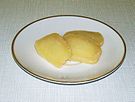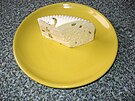| Name
|
Image
|
Region
|
Description
|
| Bałtycki
|
|
|
Polish brand of cheese.[4]
|
| Bryndza
|

|
|
Sheep milk cheese made in Poland, Slovakia.[5] Recipes differ slightly across the countries.[6]
|
| Bryndza Podhalańska
|
|
Podhale region.
|
Polish variety of the soft cheese bryndza. It is prepared with sheep milk and was registered in the European Union's Register of protected designations of origin and protected geographical indications on June 11, 2007[7] as a Protected Designation of Origin (PDO).
|
| Bundz
|
|
Traditionally produced in Podhale.
|
A sheep milk cheese.
|
| Bursztyn
|
|
|
A brand of cheese.[8] It is a mature cheese similar to Gruyere.
|
| Edamski
|
|
Mazuria.
|
A rennet cheese based on Dutch Edammer.
|
| Farmer cheese
|

|
|
In Poland, farmer cheese is similar in consistency to cottage cheese.[9] The cheese is formed into a loaf.[9] It is sometimes referred to as "pot cheese."[10]
|
| Gołka
|

|
Silesian Voivodeship.
|
Similar to oscypek, but made with milk from cattle.
|
| Gryficki
|
|
Gryfice Dairy, province of Szczecin.[11]
|
Production began in 1973.[11]
|
| Hauskyjza
|

|
Wielkopolska, Pomerania, Kuyavia, and Silesia.
|
Foodstuff made of cottage cheese, caraway and other ingredients, which are mixed, put aside for a few days to acquire the characteristic sharp flavor and tacky consistency, and then warmed and fried.
|
| Kortowski [12]
|
|
|
|
| Koryciński
|

|
Podlaskie Voivodeship in eastern Poland.
|
Hard yellow cheese made from cows' milk. Named after the town of Korycin.
|
| Królewski
|
|
Northwestern Masovia.
|
"Royal cheese"; similar in taste and appearance to Swiss Emmental.
|
| Liliput
|
|
Wielkopolska.
|
A cows' milk cheese.[13]
|
| Lechicki
|
|
|
Known in Poland as Brochocki cheese, which derives from the name of the farmer who began producing it.
|
| Łowicki [14]
|
|
|
|
| Lubuski
|
|
|
|
| Mazurski
|
|
|
A brand of cheese.
|
| Morski
|
|
|
Mild, semi-soft cheese made from pasteurized cow's milk. Melts well, often used as a table cheese.
|
| Oscypek
|

|
Made exclusively in the Tatra Mountains region of Poland.
|
Smoked sheep milk cheese, there is also a smaller form called redykołka, known as the 'younger sister' of oscypek.
|
| Przeworski
|
|
|
A rennet cheese, classified as ripening, produced from cow's milk and an infusion of mint and marjoram. It has a delicately spicy taste and an aroma of herbs. Named after the town of Przeworsk in the Subcarpathian Voivodeship.
|
| Radamer
|
|
From Polesie.
|
A cows' milk cheese, with Dutch and Swiss influence.[15]
|
| Redykołka
|
|
Produced in the Podhale region.
|
Sometimes known as the "younger sister" of Oscypek and the two are occasionally confused. The cheese is often made in the shape of animals, hearts, or decorative wreaths.
|
| Rokpol
|

|
Wielkopolska.
|
Polish blue cheese similar to Danish blue cheeses. The name derives from Roquefort and suggests that it is a Polish Roquefort, however, it is made with cows' milk.[16]
|
| Słupski chłopczyk
|
|
Produced in Słupsk.
|
A Camembert-type cheese, produced before the second world war, reintroduced in 2007, but the production was stopped in 2013.
|
| Twaróg
|

|
|
Also known as ser biały.[17] Pictured is Polish twaróg in the traditional wedge shape.
|
| Tylżycki
|
|
Mazuria.[18]
|
A yellow cheese made from cow's milk. A semi-hard cheese that is a variety of Tilsiter.[19]
|
| Zamojski
|
|
|
|
| Zgorzelecki
|
|
|
A semi-hard, yellow cheese made from cows' milk.
|







